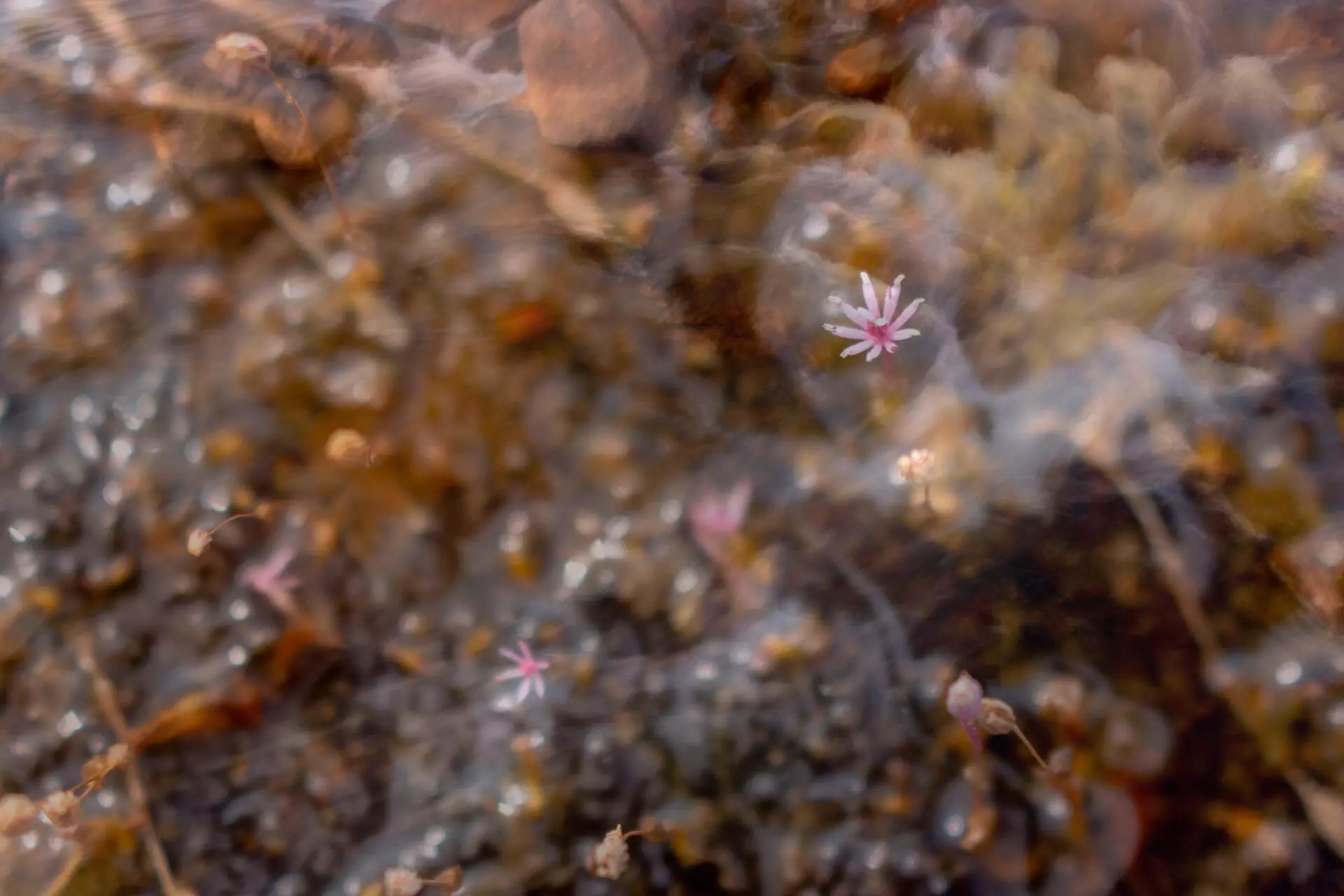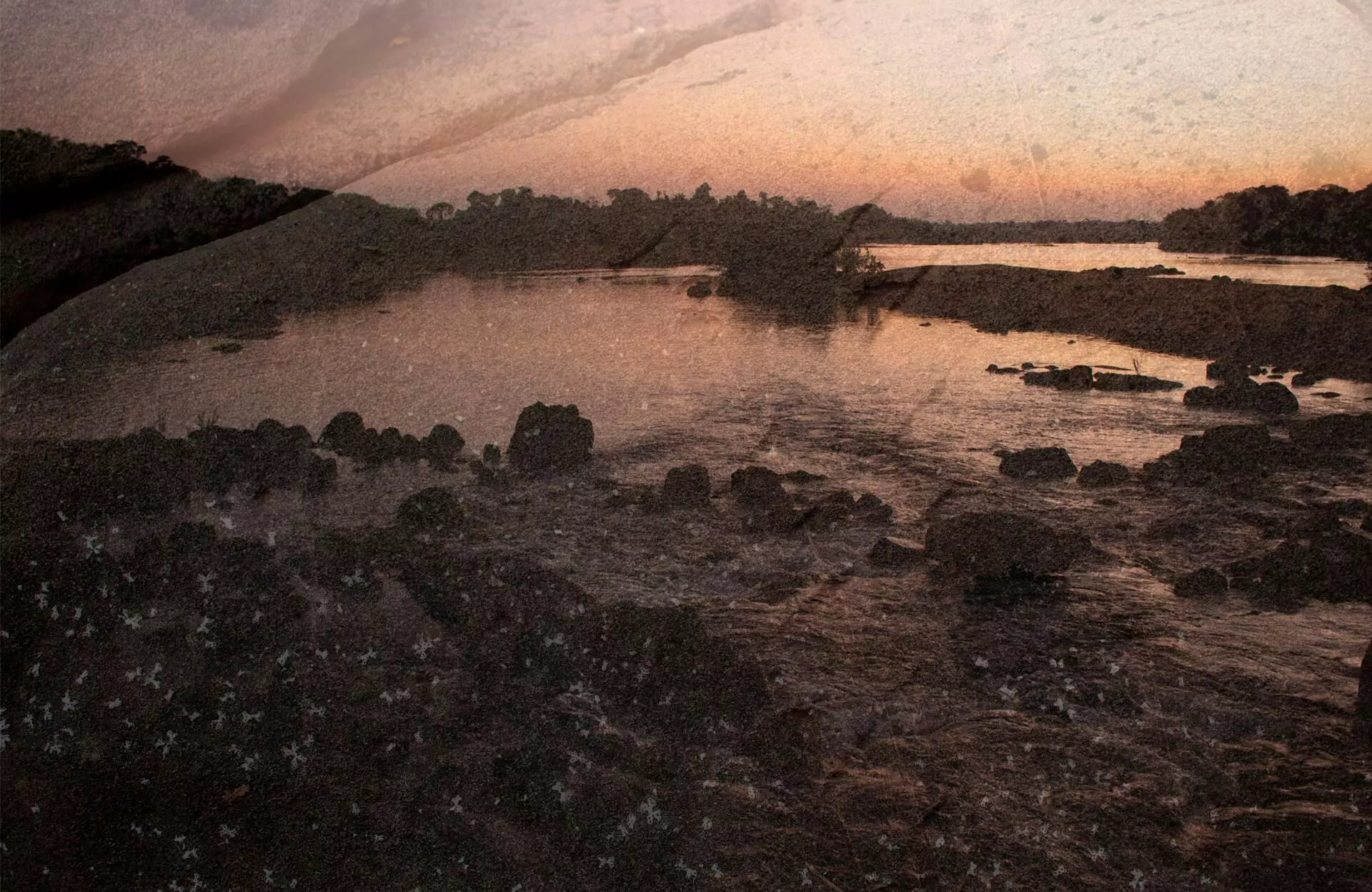Born in a canoe on Paratizinho, an island in the Xingu River in the state of Pará, Maria Francineide Ferreira dos Santos, known as Dona Francineide, finds healing and spiritual renewal in rapids and waterfalls. “Did you know waterfalls are the most powerful cleansers of river waters?” she asks, sitting on a wooden bench on Pedacinho do Céu Island, not far from Itamaracá Falls, along the stretch of the Xingu River known as the Volta Grande, or Big Bend. She also warns us that “even the loveliest one, farthest from the world’s eyes, is threatened” by greed and “big death projects.” Dona Francineide is referring to the Belo Monte hydroelectric power plant, which has silenced the region’s waters, along with many of its waterfalls.
In what the Belo Monte project calls the “stretch of reduced flow” along the Volta Grande, 70% of the water is captured by the hydropower plant, draining the region’s waterfalls and rapids of both their magic and their might. “Before, we had winter, when the waters rose. Now they don’t rise. It’s always dry,” says Agostinho Juruna, from Mïratu Village, in the Paquiçamba Indigenous Territory—much like Raimundo Berro Grosso, who devoted decades of his life to fishing on the Xingu River and saw part of it become “a lifeless lake, no forest, no beach, no feeding grounds, no fish.”
On an artistic, journalistic, and experimental journey that was all about listening, Soll, a visual artist and forest-journalist with the Mycelium-SUMAÚMA program, went in search of the mysteries, colors, and movement of waterfalls. Soll hoped to gain an understanding of what these more-than-human beings mean to the guardians of the Amazon Forest in the Middle Xingu and how they influence their lives. These reflections accompany his video story.
Everything I long for, inside me
Soll, Altamira, Xingu, 2023
It was chilly that winter morning on Ilha Pedacinho do Céu—Little Piece of Heaven Island—in Volta Grande do Xingu. Dona Francineide’s feet were still cold when she got out of her hammock as always, tied back her long black hair, peppered lightly with gray—like the foam on the nearby Itamaracá Falls—and knelt down to say her first prayers of the day, before chopping kindling for her clay wood stove so she could boil water for coffee.
In the other room, her children still hadn’t moved; they usually get up only after the aroma of coffee has invaded the house. While Dona Francineide brewed coffee in the kitchen, which is partially exposed to the outdoors, she watched a scrawny dog in the yard stretch languidly and another one nip at some pesky mosquitoes. In the background, a multitude of birds sang in chorus, competing with the tottering chicks who scurried about in pursuit of their mothers.
Before her little ones woke up, Dona Francineide set off for the riverbank, a well-polished aluminum basin balancing on her head and glistening in the first rays of sunlight. Sitting cross-legged on a board anchored near the edge of the river, she unhurriedly washed a few pots she had used to cook couscous and cassava flour, while small fish swam around her legs, feasting on the leftovers.
Done with this chore, she slipped into the water and looked out over the river, where mist still hung in the air. Thinking back, she remembered the stories her father used to tell and how he knew the Xingu like the palm of his hand. He had once told her that, like us, the river had life; it had its own habits and a lot to teach us.
In the atypical calm of that morning, with the whirling waters lapping rhythmically against the stones along the riverbank, Dona Francineide found herself in a state of total peace and tranquility. Her thoughts traveled from her mind to her lips, and without realizing it, she let these words escape: “And to think I almost gave up, my friend! I came close to never seeing the dawn on my Xingu again.”
As she pondered these things, the fog on the horizon lifted to reveal a placid, emerald-green river, while a fine mist clouded the mirror-like surface of the water around her. She ignored the mist and went on thinking louder and louder.
“When the doctor told me, I really believed I wouldn’t have the strength, but I clung to my man too. Old-timers used to say, ‘Women have to know how to look after their husbands’—but they don’t know how to look after us. That’s what I discovered when he started going out all dressed up, not telling me where or when he’d be back.”
Immersed in memory, her emotions reaching deeper into her soul, Francineide felt the river was a good listener, and so she went on, pouring out her thoughts.
“He left when I needed him most, and it crushed my heart. The children needed him too. I had no choice, and so I continued carrying the world on my shoulders, even thinking it was my own fault, can you believe that?! Like a dam on the river, a malignant tumor settled into my womb. Once again, it was up to me to learn from the Xingu that we have to be strong and resist.”
Her voice broke with emotion. At times she had to pause to let the dammed-up water flow to the riverbed, until she regained her composure and could go on, a slight smile emerging on her face: “Thank you, Xingu. You look after me and listen to me, and I’m going to look after you too. Of everything you’ve taught me, the most valuable was discovering that all the strength and love I need are inside me.”
When she said these last words, Francineide felt light as dry straw, and she floated away on a gentle current.
Soll
Altamira, Pará State, 2023

Photo layout: Soll/Sumaúma
The Mycelium-SUMAÚMA Forest-Journalist Co-Training Program began in May 2023. Fourteen young people from the Middle Xingu—four Indigenous youth, three youth from traditional forest communities, one from a quilombola community, one small-hold farmer, a fisherwoman, an Indigenous health nurse, and young people from urban communities in the city of Altamira—participate in gatherings in the forest and the city. The youth are guided by senior journalists at SUMAÚMA, known as “seed-mentors,” who are in turn guided by the youth, since co-training is an exchange. In this film-report, Malu Delgado and Lela Beltrão were the seed-mentors.
Coordinated by Raquel Rosenberg, co-founder of Engajamundo, the teaching method used by Mycelium-SUMAÚMA, deliberately eschews any type of orthodoxy. Conceived by Eliane Brum (likewise responsible for supervision and content) and Jonathan Watts, the program maintains the rigor, responsibility, and accuracy of traditional journalism.
Micélio-SUMAÚMA also includes psychoanalyst Ilana Katz, providing care consulting, and producer Thiago de Sousa Leal. Mônica Abdalla is responsible for managing the Program’s finances, with administrative and financial assistant Marina Borges and financial consulting from Mariana Zahar. Micélio-SUMAÚMA receives funding from the Moore Foundation and the Google News Initiative.
Seed-mentors: Malu Delgado (journalism) and Lela Beltrão (photography)
Fact-checker: Plínio Lopes
Proofreader (Portuguese): Valquíria Della Pozza
Spanish translation: Meritxell Almarza
English translation: Diane Whitty
Layout and finishing: Érica Saboya
Editors: Viviane Zandonadi (editorial workflow and copy editing), and Talita Bedinelli (editor-in-chief)
Director: Eliane Brum






